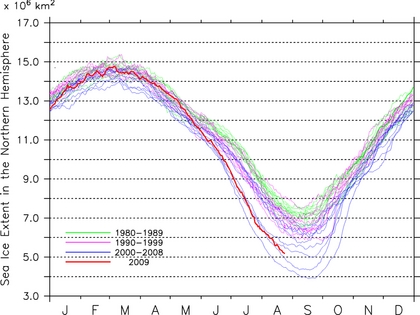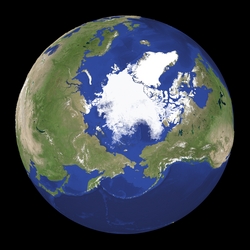2009.08.25
GIC Weekly Report for the Arctic Region Vol.4
Atmospheric circulation delays opening of the Eastern passage
Topic of the Week
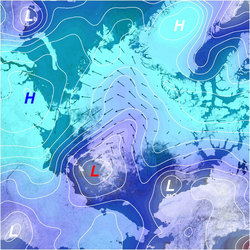
Figure 1. The current atmospheric situation depicting pressure contours at surface level and ice vectors (arrows) in the Arctic region
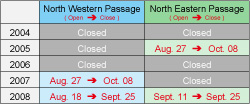
Table 1. Significant opening periods in past years of the North Western and North Eastern passages
Atmospheric circulation has dictated ice movement throughout the last few weeks, this is set to continue as sea ice around the Arctic decreases. This is evident in both passages firstly in the Eastern passage throughout the Taimyr peninsula and Eastern Siberian Sea and secondly, in the Western passage where ice continues to melt in the Canadian Arctic West Sea. The synoptic situation (Figure 1), at present shows a high pressure system (depicted as blue "H" at the left side of Figure 1) residing over the Taimyr peninsula, resulting in clear skies and the resultant melting of sea ice, although temperatures are set to decrease as northeasterly winds bring colder arctic air from high latitudes. The North Western passage is also dictated by a high pressure system, although unlike the North Eastern passage, a southerly wind will keep temperatures around 10-20oC over the next few weeks. This difference in temperature within the two passage has the characteristics of a typical EL Nino year.
The movement of ice is known to be influenced by the atmospheric circulation and synoptic condition, at present the influential feature within the arctic region (shown in figure 1), is a low pressure system (depicted by a red "L" near the centre of Figure 1) which is situated over the Eastern Siberian Sea, this has resulted in sea ice migration eastwards, towards the Taimyr peninsula, current surface winds of around 20 knots suggests that the sea ice is moving at a rate of 0.2-0.3m/s.
Sea Ice Extent
For this time of year, the sea ice extent for the Northern Hemisphere is recorded to be the third lowest ever recorded within historical records. The North Western/Eastern passages are also recorded to be the third lowest sea ice extent in recorded history. The above indicates a continued decline in sea ice throughout the Arctic region. Figure 3. shows the extent of ice over the Arctic region.
Sea Ice Conditions along Polar Routes
| NW Passage |
| Gulf of St.Lawrence |
Grand Banks |
Labrador Sea |
Davis Strait |
Baffin Bay |
Canadian Arctic E |
Canadian Arctic W |
Beaufort region |
Chukchi | Bering West |
| IF | IF | IF | IF | IF | IF | IF | IF | IF | |
| Greenland Sea SW |
Foxe Basin |
||||||||
| IF |
| NE Passage |
| Bering West |
Chukchi | East Siberian |
Laptev | Kara Sea N |
Barents Sea NE |
Barents Sea S |
Barents Sea NW |
| IF | IF | IF | IF | IF | IF | ||
| Kara Sea S |
|||||||
| IF |
| Ice Concentration | Passage situation | |
| equal or more than 7 |
ships can not sail without icebreaker | |
| 4-6 | ice-strengthend ships can sail | |
| less than 3 | ice-worthy ships can sail | |
| IF | Ice Free | normal ships can sail |
Table 2. Sea ice extent for each region in the Arctic, showing the labelled colors to indicate navigable routes around the North Eastern and North Western passages.
The Eastern and Western passages remain closed for the time being, although melting is still occurring around all regions. In the Canadian Arctic Western Sea, ice continues to decline, this has resulted in areas near the coast of Somerset island having ice concentrations of only 1-2, allowing the possibility for smaller ice strengthened vessels to travel through the James Ross strait, although shallow shoals will make this route inaccessible to most vessels. Other areas within the Western passage remain clear with the exception of Foxe Basin, which is only accessible by smaller ice strengthened vessels, although continuing trends predict that this area will continue to clear.
The North Eastern passage is now only blocked at the Taimyr peninsula, throughout the past week, melting of sea ice has occurred within the East Siberian Sea, allowing vessels to pass through the Lapteva strait. Within the Laptev Sea and Kara Sea North ice continues to melt with 8-9/10th ice concentration throughout these regions.
Model Prediction
Weathernews's I-SEE engine indicates that within the North Eastern passage there will be a shoreward migration of ice at the Taimyr peninsula, this movement of ice is being driven by a surface low pressure system, bringing shoreward winds and colder temperatures of 0-5oC. This atmospheric condition is not ideal for the opening of the Eastern routes as it is expected that sea ice will migrate to this passage particularly to the Taimyr peninsula.
Within the North Western passage, sea ice is set to decline within the Canadian Arctic regions, productively decreasing ice concentrations to 60% in areas. Within the Beaufort Sea, sea ice accumulations that have gathered over the last week due to ice movement led by atmospheric motion are set to decline, effectively reopening the area, It is predicated that sea ice in this region will move east following the current atmospheric circulation.
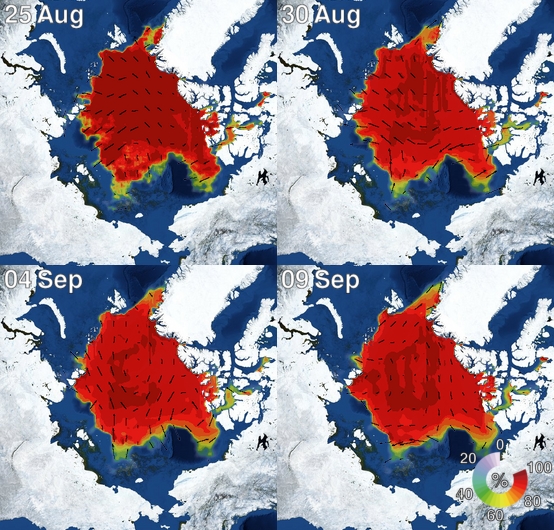
Figure 4. I-SEE engine, model predictions of the arctic sea ice


